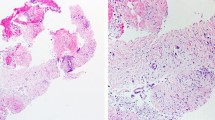Abstract
Background
In many centers, rapid on-site evaluation (ROSE) for the specimens obtained from endoscopic ultrasound-guided fine-needle aspiration biopsy (EUS-FNAB) is not available. The aim of this study was to compare the diagnostic yields of EUS-FNAB in the presence or absence of ROSE.
Methods
Seventy-five patients who underwent EUS-FNAB for the pancreatic, gastric subepithelial, and mesenteric mass lesions at our institution from November 2013 to August 2014 were included. For 20 patients in the pilot cohort, EUS-FNAB was performed with ROSE, and simultaneously, training of the staff endosonographer for tissue adequacy by an on-site cytopathologist was also performed.
Results
The sensitivity, specificity, positive predictive value (PPV), negative predictive value (NPV), and accuracy of EUS-FNAB in the pilot cohort were 91.7, 100.0, 100.0, 88.9, and 95.0 %, respectively. The 3.2 ± 0.8 [mean ± standard deviation (SD)] needle passes were needed in this cohort. Fifty-five patients were enrolled as a validation cohort from April 2014 to August 2014, and tissue adequacies were assessed by an experienced endosonographer without ROSE in this cohort. The sensitivity, specificity, PPV, NPV, and accuracy of EUS-FNAB in this validation cohort were 92.1, 100.0, 100.0, 85.0, and 94.6 %, respectively. The 4.5 ± 0.6 (mean ± SD) needle passes were needed in this cohort (p < 0.01 compared to pilot cohort).
Conclusions
Diagnostic accuracy of EUS-FNAB in which the adequacy of sample was assessed by an attending endosonographer was acceptable. This study suggests that on-site evaluation by a trained endosonographer may be an alternative tool to ROSE where ROSE is not available.

Similar content being viewed by others
Abbreviations
- EUS-FNAB:
-
Endoscopic ultrasound-guided fine-needle aspiration and biopsy
- GIST:
-
Gastrointestinal stromal tumor
- IPMN:
-
Intraductal papillary mucinous neoplasm
- NPV:
-
Negative predictive value
- NS:
-
Not significant
- PPV:
-
Positive predictive value
- ROSE:
-
Rapid on-site evaluation
- SD:
-
Standard deviation
References
Chang KJ, Nguyen P, Erickson RA, Durbin TE, Katz KD (1997) The clinical utility of endoscopic ultrasound-guided fine-needle aspiration in the diagnosis and staging of pancreatic carcinoma. Gastrointest Endosc 45:387–393
Varadarajulu S, Eloubeidi MA (2010) The role of endoscopic ultrasonography in the evaluation of pancreaticobiliary cancer. Surg Clin N Am 90:251–263
Dewitt J, Devereaux BM, Lehman GA, Sherman S, Imperiale TF (2006) Comparison of endoscopic ultrasound and computed tomography for the preoperative evaluation of pancreatic cancer: a systematic review. Clin Gastroenterol Hepatol 4:717–725
Chhieng DC, Jhala D, Jhala N et al (2002) Endoscopic ultrasound-guided fine-needle aspiration biopsy: a study of 103 cases. Cancer (Cancer Cytopathol) 96:232–239
Iglesias-Garcia J, Dominguez-Munoz JE, Abdulkader I et al (2011) Influence of on-site cytopathology evaluation on the diagnostic accuracy of endoscopic ultrasound-guided fine-needle aspiration (EUS-FNA) of solid pancreatic masses. Am J Gastroenterol 106:1705–1710
Klapman JB, Logrono R, Dye CE et al (2003) Clinical impact of on-site cytopathology interpretation on endoscopic ultrasound guided fine-needle aspiration. Am J Gastroenterol 98:1289–1294
Savoy AD, Raimondo M, Woodward TA et al (2007) Can endosonographers evaluate on-site cytologic adequacy? A comparison with cytotechnologists. Gastrointest Endosc 65:953–957
Schmidt RL, Witt BL, Matynia AP, Barraza G, Layfield LJ, Adler DG (2013) Rapid on-site evaluation increases endoscopic ultrasound-guided fine-needle aspiration adequacy for pancreatic lesions. Dig Dis Sci 58:872–882
Witt BL, Adler DG, Hilden K, Layfield LJ (2013) A comparative needle study: EUS-FNA procedures using the HD ProCore™ and EchoTip® 22-gauge needle types. Diagn Cytopathol 41:1069–1074
Nguyen YP, Maple JT, Zhang Q et al (2009) Reliability of gross visual assessment of specimen adequacy during EUS-guided FNA of pancreatic masses. Gastrointest Endosc 69:1264–1270
LeBlanc JK, Ciaccia D, Al-Assi MT et al (2004) Optimal number of EUS-guided fine needle passes needed to obtain a correct diagnosis. Gastrointest Endosc 59:475–481
Author information
Authors and Affiliations
Corresponding author
Ethics declarations
Disclosures
This study was financially supported by a grant from Myungmoon Pharmaceuticals (Seoul, Korea).
Rights and permissions
About this article
Cite this article
Kim, H.J., Jung, Y.S., Park, J.H. et al. Endosonographer’s macroscopic evaluation of EUS-FNAB specimens after interactive cytopathologic training: a single-center prospective validation cohort study. Surg Endosc 30, 4184–4192 (2016). https://doi.org/10.1007/s00464-015-4727-3
Received:
Accepted:
Published:
Issue Date:
DOI: https://doi.org/10.1007/s00464-015-4727-3




